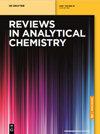Biological nanoscale fluorescent probes: From structure and performance to bioimaging
IF 3.8
3区 化学
Q2 CHEMISTRY, ANALYTICAL
引用次数: 15
Abstract
Abstract In recent years, nanomaterials have attracted lots of attention from researchers due to their unique properties. Nanometer fluorescent materials, such as organic dyes, semiconductor quantum dots (QDs), metal nano-clusters (MNCs), carbon dots (CDs), etc., are widely used in biological imaging due to their high sensitivity, short response time, and excellent accuracy. Nanometer fluorescent probes can not only perform in vitro imaging of organisms but also achieve in vivo imaging. This provides medical staff with great convenience in cancer treatment. Combined with contemporary medical methods, faster and more effective treatment of cancer is achievable. This article explains the response mechanism of three-nanometer fluorescent probes: the principle of induced electron transfer (PET), the principle of fluorescence resonance energy transfer (FRET), and the principle of intramolecular charge transfer (ICT), showing the semiconductor QDs, precious MNCs, and CDs. The excellent performance of the three kinds of nano fluorescent materials in biological imaging is highlighted, and the application of these three kinds of nano fluorescent probes in targeted biological imaging is also introduced. Nanometer fluorescent materials will show their significance in the field of biomedicine.生物纳米级荧光探针:从结构和性能到生物成像
摘要近年来,纳米材料以其独特的性能引起了研究人员的广泛关注。纳米荧光材料,如有机染料、半导体量子点(QDs)、金属纳米团簇(MNCs)、碳点(CDs)等,因其灵敏度高、响应时间短、精度优异而广泛应用于生物成像领域。纳米荧光探针不仅可以对生物体进行体外成像,而且可以实现体内成像。这为医护人员治疗癌症提供了极大的便利。结合现代医学手段,更快、更有效地治疗癌症是可以实现的。本文阐述了三纳米荧光探针的响应机理:诱导电子转移原理(PET)、荧光共振能量转移原理(FRET)和分子内电荷转移原理(ICT),显示了半导体量子点、贵重MNCs和cd。重点介绍了这三种纳米荧光材料在生物成像中的优异性能,并介绍了这三种纳米荧光探针在靶向生物成像中的应用。纳米荧光材料将在生物医学领域显示其重要意义。
本文章由计算机程序翻译,如有差异,请以英文原文为准。
求助全文
约1分钟内获得全文
求助全文
来源期刊

Reviews in Analytical Chemistry
化学-分析化学
CiteScore
7.50
自引率
0.00%
发文量
15
审稿时长
>12 weeks
期刊介绍:
Reviews in Analytical Chemistry publishes authoritative reviews by leading experts in the dynamic field of chemical analysis. The subjects can encompass all branches of modern analytical chemistry such as spectroscopy, chromatography, mass spectrometry, electrochemistry and trace analysis and their applications to areas such as environmental control, pharmaceutical industry, automation and other relevant areas. Review articles bring the expert up to date in a concise manner and provide researchers an overview of new techniques and methods.
 求助内容:
求助内容: 应助结果提醒方式:
应助结果提醒方式:


